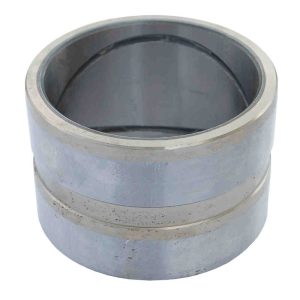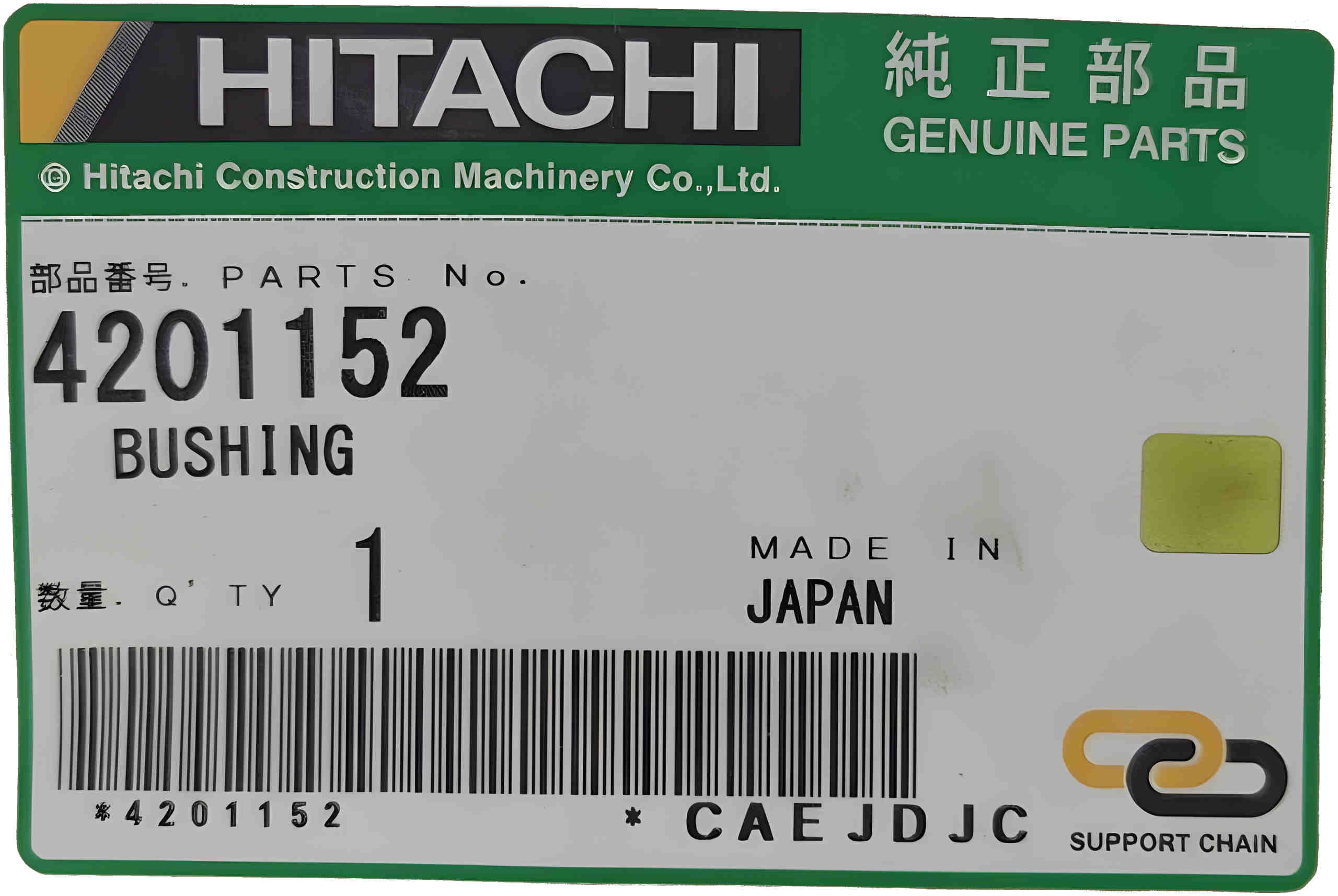When it comes to heavy machinery like Hitachi excavators and mining shovels, every component plays a critical role in ensuring durability, efficiency, and safety. Among these components, bushings stand out as a key element in maintaining optimal performance. Designed specifically for the harsh conditions of mining and construction, bushings are engineered to deliver unmatched reliability, reduce downtime, and enhance the lifespan of equipment. In this post, we’ll explore the importance of bushings, their material advantages, cost-saving benefits, and why Hitachi excavators remain a dominant force in the industry.
The Role of Bushings in Mining and Excavation Equipment
Bushings are cylindrical mechanical components that reduce friction, absorb shock, and allow smooth movement between parts. In mining shovels and Hitachi excavators, they are used in critical areas like boom joints, bucket arms, and undercarriage systems. These parts are subjected to extreme pressure, vibration, and abrasive materials, making quality bushings essential for maintaining performance and safety.
While Original Equipment Manufacturer (OEM) parts are synonymous with quality and reliability, aftermarket OEM-quality bushings offer a compelling alternative for businesses seeking cost savings, flexibility, and performance without compromising on standards.
Why Hitachi Excavators Dominate the Market
Hitachi is a global leader in construction and mining equipment, with a strong presence in markets like North America, Asia-Pacific, and Europe. According to industry reports, Hitachi excavators hold a significant share of the global market, with over 15% of the global excavator sales in 2023, driven by their reliability, fuel efficiency, and advanced technology.
For example, Hitachi EX Series excavators are used in a wide variety of applications globally, including mining and quarrying, large-scale earthmoving and infrastructure projects, general construction, and even in some forestry and demolition applications. These ultra-large hydraulic excavators are built for durability and high productivity in demanding, heavy-duty environments. The company’s focus on innovation – such as hybrid excavators and intelligent control systems – has solidified its reputation as a trusted brand in the industry.
With such popularity, ensuring that parts like bushings are compatible and high-quality is crucial for maintaining the performance of these machines.
Why Cost Savings with OEM-quality Bushings is a Smart Choice?
1. Cost Savings Without Compromising Quality
One of the most significant advantages of aftermarket OEM-quality bushings is lower pricing. While OEM parts are often 20–50% more expensive, reputable aftermarket suppliers can produce parts that meet the same specifications, materials, and durability standards as OEM, at a fraction of the cost. This makes them ideal for:
- High-volume operations where cost per unit matters.
- Budget-conscious maintenance teams needing replacements quickly.
- Companies upgrading bushings for older equipment (e.g., Hitachi excavators) where OEM parts are no longer manufactured.
Pro Tip: Always compare labor and downtime costs with the price of the part. Even if an aftermarket part is slightly cheaper, its longevity and performance can save money over time.
2. Faster Availability and Lead Times
OEM parts can suffer from long lead times, especially for specialized equipment like Hitachi excavators or mining shovels. Aftermarket suppliers often maintain larger inventory and can deliver parts within days, not weeks. This is critical for:
- Preventive maintenance schedules.
- Emergency repairs to avoid downtime.
- Global operations where OEM parts may be unavailable in certain regions.
Pro Tip: Choose suppliers with local or regional warehouses to minimize delivery delays.
3. Customization and Flexibility
Aftermarket OEM-quality bushings can be tailored to specific applications, such as:
- Custom dimensions for non-standard equipment.
- Material upgrades (e.g., using higher-grade steel or coatings).
- Design modifications to improve performance or reduce wear.
This flexibility is rarely possible with original OEM parts, which are limited to the manufacturer’s specifications.
Pro Tip: Work with suppliers that offer custom engineering services to ensure parts meet your unique needs.
4. Warranties and Returns Policies
While OEM parts often come with manufacturer warranties, aftermarket suppliers may also offer comparable warranties and return policies. This provides peace of mind and reduces the risk of investing in subpar parts.
5. Environmental and Sustainability Benefits
Some aftermarket manufacturers prioritize eco-friendly practices, such as:
- Recycling old parts to reduce waste.
- Using sustainable materials or coatings.
- Lowering carbon footprints through efficient production.
This can be a key selling point for companies with ESG (Environmental, Social, Governance) goals.
The Importance of Grease Channels
One of the standout features of bushings used in large Hitachi excavators is the inclusion of grease channels. These channels are integrated into the bushing design to allow for lubrication without disassembly, which is a game-changer for maintenance efficiency.
Benefits of Grease Channels Include:
- Extended Lifespan: Proper lubrication reduces friction and wear, extending the life of the bushing and surrounding components.
- Contamination Prevention: Grease channels help trap debris and moisture, preventing them from entering the bearing system and causing damage.
- Ease of Maintenance: Operators can lubricate bushings quickly and easily without removing them, saving time and labor costs.
Why AISI 4140/4142 Steel is the Standard
The material quality of bushings directly impacts their strength, durability, and performance in harsh environments. OEM bushings for Hitachi excavators are typically made from AISI 4140 or 4142 steel, which are quench and tempered to 53–58 Rockwell hardness (RC).
Key Advantages of AISI 4140/4142 Steel:
- High Strength and Toughness: These steels are resistant to deformation and fatigue, making them ideal for heavy-duty applications.
- Wear Resistance: The quench and temper process enhances their surface hardness, reducing wear from abrasive materials like rock and soil.
- Corrosion Resistance: While not as corrosion-resistant as stainless steel, AISI 4140/4142 steel is coated or treated to withstand exposure to moisture and chemicals in mining environments.
Comparison with Other Materials:
- Cast Iron: While cheaper, cast iron bushings are prone to cracking under heavy loads and lack the wear resistance of AISI 4140/4142 steel.
- Stainless Steel: Offers better corrosion resistance but is more expensive and less durable under high-stress conditions.
- Aluminum: Lightweight but not suitable for heavy machinery due to its low strength and susceptibility to deformation.
For mining and excavation equipment, AISI 4140/4142 steel is the gold standard, ensuring that bushings can handle the rigors of continuous operation without compromising performance.
How to Ensure the Best Quality-to-Price Ratio
To avoid subpar parts and maximize value, follow these steps:
1. Vet the Supplier’s Reputation
- Check certifications: Look for ISO 9001, ASTM, or other industry-standard certifications.
- Ask for case studies: Reputable suppliers will share examples of parts used in similar equipment (e.g., Hitachi excavators).
2. Confirm Material and Manufacturing Standards
- Request material test reports (e.g., hardness testing, tensile strength).
- Ensure the part uses the same materials as OEM (e.g., AISI 4140/4142 steel, quench and temper to 53–58 RC).
- Verify production processes (e.g., CNC machining, heat treatment).
3. Prioritize Compatibility and Fit
- Request CAD drawings or 3D models for precise fitment.
- Ask for OEM part numbers to ensure the aftermarket part is a drop-in replacement.
- Test samples if possible (e.g., trial orders for critical components).
4. Negotiate Bulk Discounts and Payment Terms
- Leverage volume purchases to secure better pricing.
- Negotiate flexible payment terms (e.g., net 30 or 60 days) for large orders.
5. Monitor Performance and Feedback
- Track part longevity (e.g., how often replacements are needed).
- Collect feedback from technicians or operators about wear, noise, or performance.
- Use data analytics to compare costs and failures over time.
Final Thoughts: Balancing Cost, Quality, and Performance
Aftermarket OEM-quality bushings are a win-win for businesses that need cost-effective, reliable parts without sacrificing quality. The key is to select suppliers with proven track records, rigorous standards, and transparent policies. By doing so, you can achieve maximum savings while ensuring your equipment operates at peak performance – whether it’s a Hitachi excavator or a mining shovel.
Remember: The cheapest part is not always the best, but the best value lies in balancing cost, quality, and long-term performance.
-
Sale!

Bushing for Mining Shovels Hitachi Excavators
Price range: $62.00 through $507.00 Select options This product has multiple variants. The options may be chosen on the product page
Hitachi bushing compatibility table
| Location / Description | Part number | Other P/N | Compatible Hitachi Model(s) |
| Arm & Bucket | 4228349 | P-010359 | EX2500; EX3500; EX3600-5; EX3600-6 |
| Arm & Bucket | 4201152 | P-005458 | EX3500; EX3600-5; EX3600-6; EX3600E-6 |
| Arm & Bucket | 4228503 | P-010383 | EX3500; EX3600-5; EX3600-6 |
| Arm & Link Backhoe | 4148855 | P-010357 | UH261, Generic Hitachi excavators (catalog listings) |
| Arm & Link Backhoe | 4228350 | P-010379 | EX3500; EX3600-5; EX3600-6 |
| Boom & Arm | 4204267 | P-005431 | EX3500; EX3600-5; EX3600-6; EX3600E-6 |
| Boom & Arm Cylinder | 4193448 | P-005445 | EX3500; Hitachi mining shovel/excavator family |
| Boom & Loading Arm | 4193395 | P-005427 | EX3500; EX3600-5; EX3600-6; EX3600E-6 |
| Boom Frame & Side Arm Bucket Pivot | 3082141 | P-005413 | EX5500; EX5500-5; EX5500-6; EX5500E-6; EX5600-6BH; EX5600-6LD |
| Bucket & Bucket Cyl | 4401731 | P-005522 | EX5500; EX5500-5 |
| Bucket & Bucket Cyl | 4401730 | P-005521 | EX5500; EX5500-5; EX5500-6; EX5500E-6; EX5600-6LD |
| Bucket & Dump Cylinder | 4401813 | P-005529 | EX5500; EX5500-5; EX5500-6; EX5500E-6; EX5600-6LD |
| Frame & Boom | 4201150 | P-005429 | EX3500; EX3600-5; EX3600-6; EX3600E-6 |
| Frame & Boom | 4401021 | P-005517 | EX5500; EX5500-5; EX5500-6; EX5500E-6; EX5600-6BH; EX5600-6LD |
| Frame & Boom Cyl | 4193447 | P-005428 | EX3500; EX3600-5; EX3600-6; EX3600E-6 |
| Frame & Boom Cyl | 4398740 | P-005491 | EX5500; EX5500-5; EX5500-6; EX5500E-6; EX5600-6BH; EX5600-6LD |
| Front & Rear Bucket | 4400651 | P-005512 | EX5500; EX5500-5; EX5500-6; EX5500E-6; EX5600-6LD |
| Front & Rear Bucket | 4400649 | P-005505 | EX5500 family (catalog listings) |
| Front Bucket & Dump Cyl | 4193455 | P-005486 | EX3500; EX3600-5; EX3600-6; EX3600E-6 |
| Link & Bucket Backhoe | 4385639 | P-010361 | EX2500; EX2500-5; EX2500-6; EX2600-6BH |
| Rear & Front Bucket | 4193396 | P-005483 | EX3500; EX3600-5; EX3600-6; EX3600E-6 |
* Most of the compatibility listings above come from Hitachi parts catalogue and aftermarket suppliers. Please check your product manual for exact part number.

Leave a Reply